Ground Truthing USDA’s June Acreage Report
TOPICS
Soybeans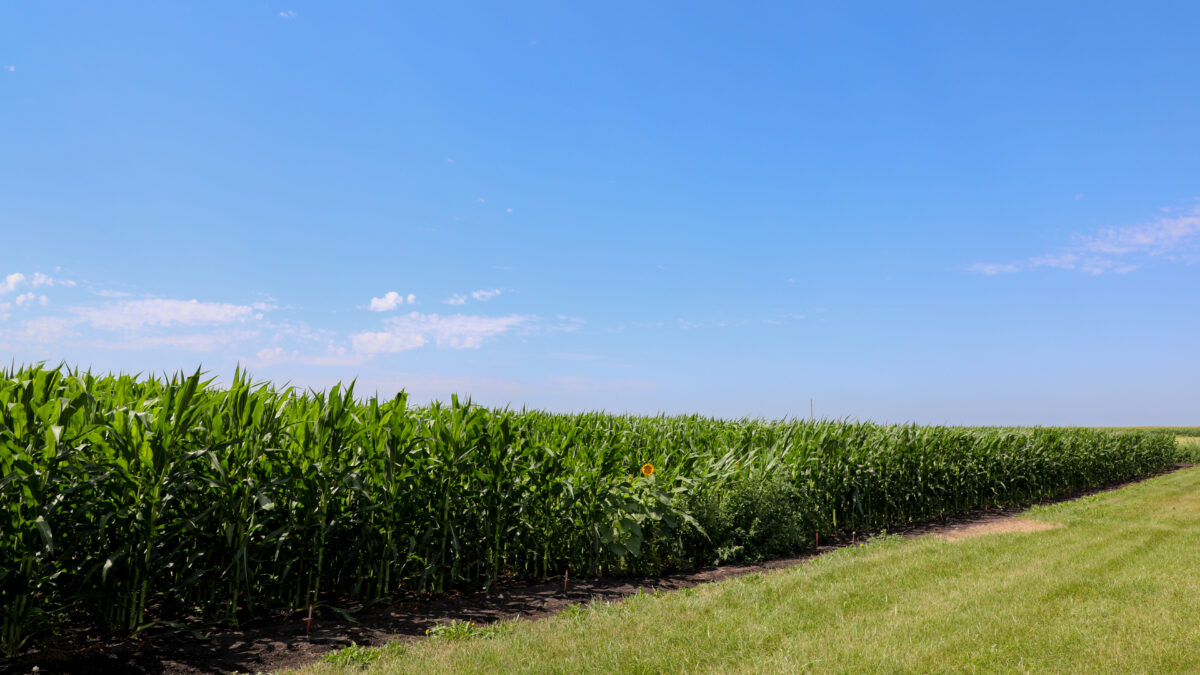
photo credit: Right Eye Digital, Used with Permission
John Newton, Ph.D.
Former AFBF Economist
The 2019 growing season will go down as one of the most challenging planting seasons on record due to spring flooding and persistent rainfall across the Midwest. Planting progress for corn and soybeans was historically delayed, i.e., Crop Planting Delays Reach Historic Levels Resulting in High Levels of Uncertainty for 2019, and current expectations are for prevent plant crop insurance claims to exceed $1 billion and reach a record-high of 10 million acres.
USDA’s June World Agricultural Supply and Demand Estimates recognized the challenges faced in the 2019 crop year and adjusted corn planted acreage down to 89.8 million acres, a reduction of 3 million acres from the department’s March estimate, and also reduced the crop yield from 176 bushels per acre to 166 bushels per acre.
USDA reversed course in its annual survey-based June Acreage Report. For the 2019/20 crop year, USDA indicated corn planted area at 91.7 million acres, up 3% or 2.6 million acres from prior-year levels, and down only slightly from March intentions of 92 million acres planted. Importantly, USDA’s June corn acreage estimate was up from the June WASDE projection and well above the average pre-report estimate of 86.6 million acres. Figures 1 and 2 highlight USDA’s corn acres planted or intended to be planted and the year-over-year change from 2018.
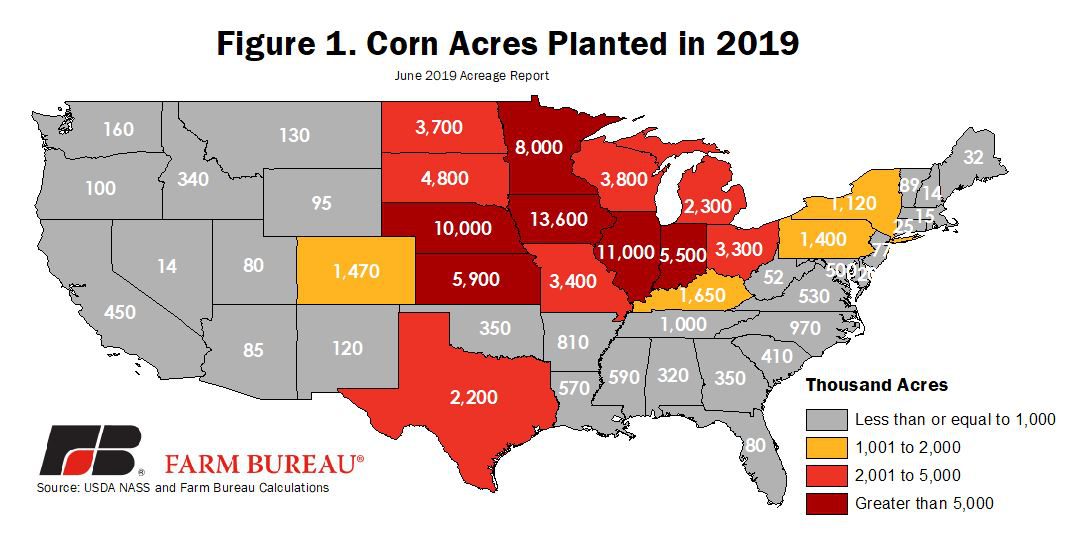
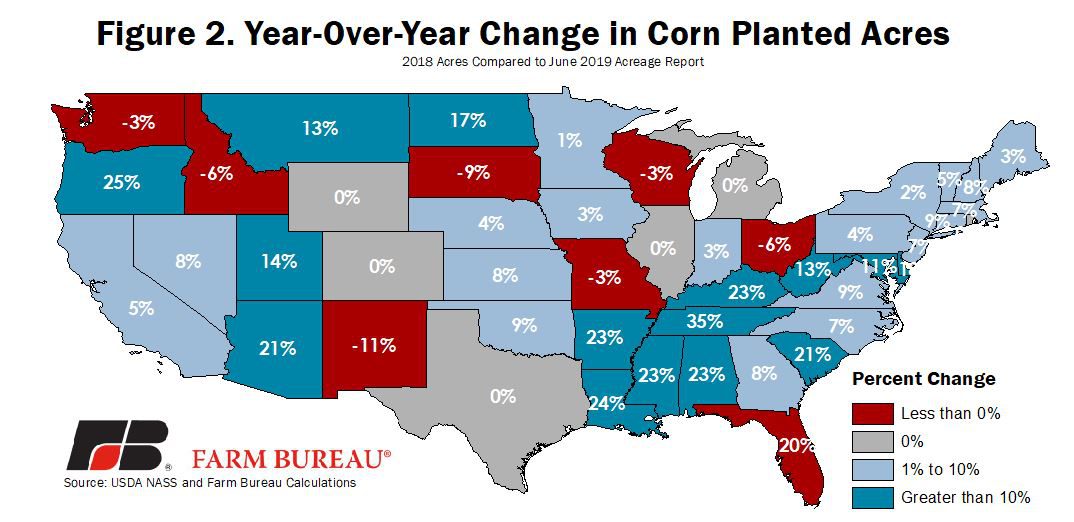
Following continued declines in new-crop soybean prices – due to substantially lower Chinese demand – USDA revealed soybean acres planted at 80 million acres, down 9.2 million acres, or 10%, from 2018 and down 4.6 million acres from March intentions. Soybean plantings in 2019 are expected to be the lowest since 2013, and plantings are expected to be lower in all 29 soybean-producing states. Figures 3 and 4 highlight USDA’s soybean acres planted or intended to be planted and the year-over-year change from 2018.
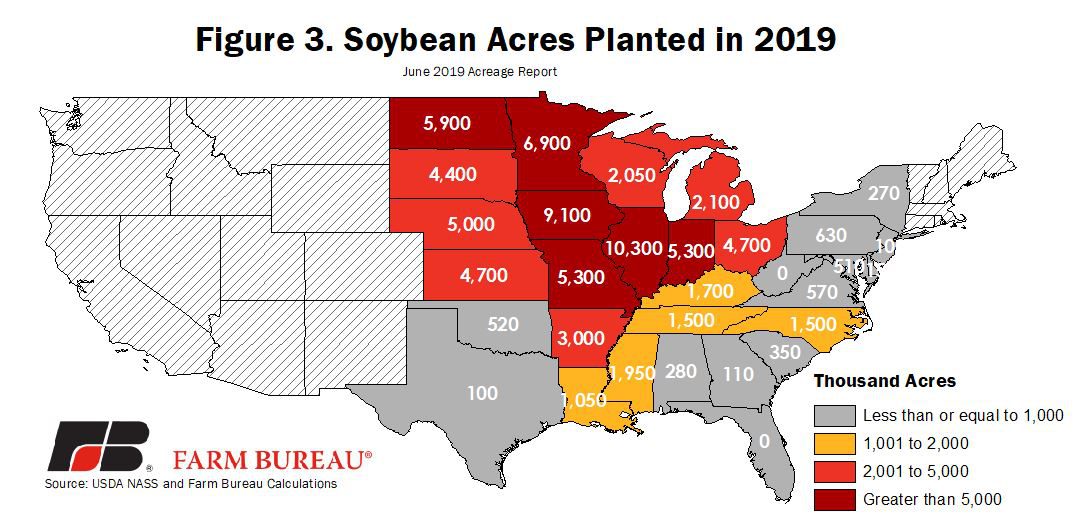
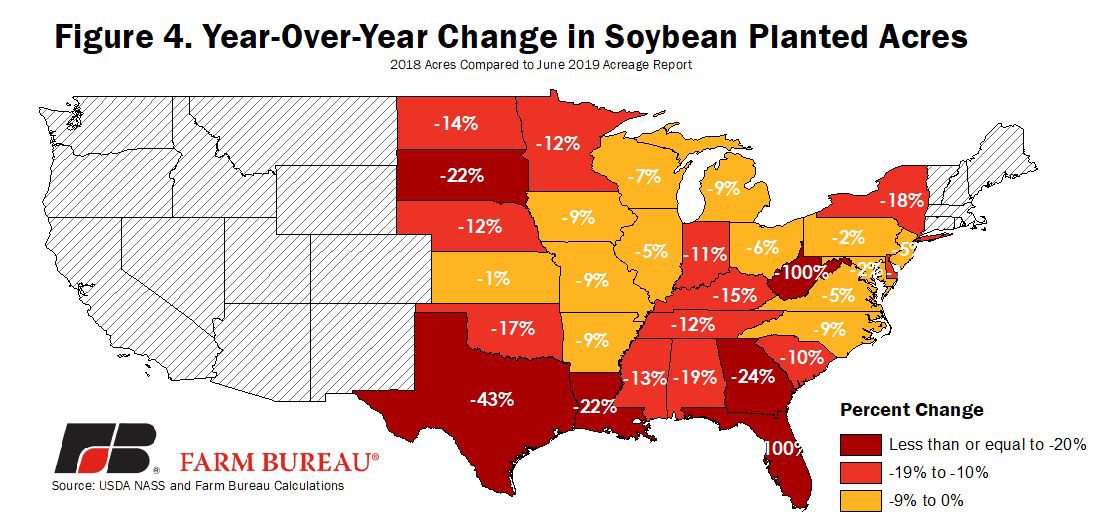
USDA Will Reinterview
It is an understatement to say USDA’s report surprised the corn market. New-crop corn futures fell by more than 19 cents and represented a $2.6 billion-reduction in the value of new-crop corn (based on WASDE production estimates). USDA acknowledged as much, indicating that 83% of the intended corn acreage had been planted at the time of the survey – well below the 10-year average.
In order to provide a more accurate estimate of the crop size and planted area, USDA announced that it will resurvey farmers in advance of the August 12 Crop Production report. Farmers in 14 states will be reinterviewed to determine their planted area of corn, soybeans and sorghum. Figure 5 identifies the states subject to acreage resurveys.
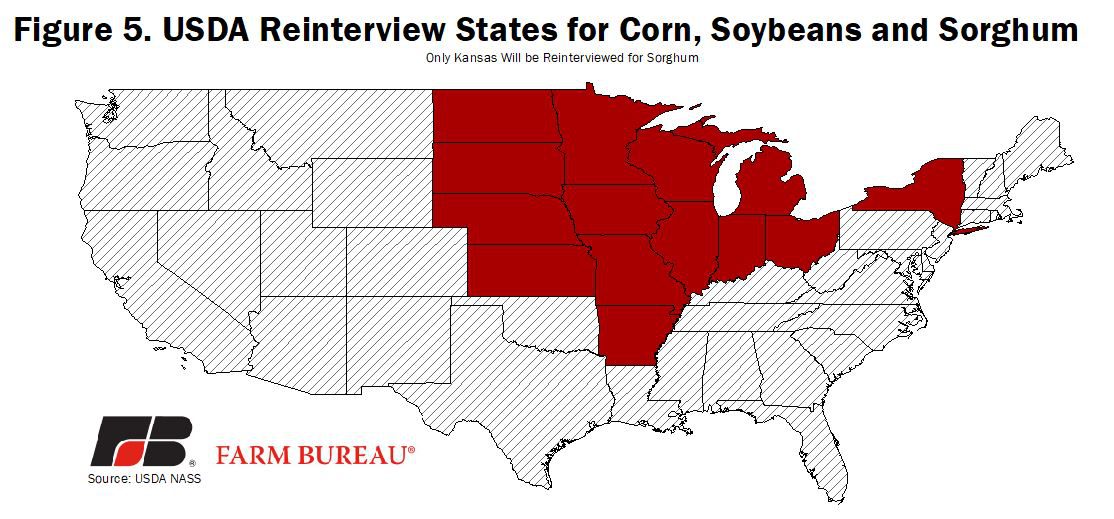
State Farm Bureau Perspective
To provide some additional perspective on corn and soybean acres planted, remaining to be planted or prevented from being planted, state Farm Bureaus in the reinterview region were contacted to get their ground-level perspective. Their responses follow.
Illinois – Corn Acres Unchanged and Soybean Acres Down 5%
A central Illinois farmer reported to me over this past weekend, that he had one field he originally planned to plant to corn, then was prevented-planting of corn on that field, and now he has just finished planting soybeans on that field. [Market Intel note: The planting of soybeans may have been motivated by the planting requirement associated with the Market Facilitation Program.]
Indiana – Corn Acres Up 3% and Soybean Acres Down 11%
Farmers in Indiana have given up on the hope of getting any more corn planted and did so several weeks ago. Prevent planted acres are all around the state, particularly in central and southern Indiana, where farmers have experienced rainfall far above normal. Corn can be seen in the state just popping out of the ground to knee high. Anticipated yields at this time will be far less than the 10-year average for farmers.
Kansas – Corn Acres Up 8% and Soybean Acres Down 1%
While a majority of intended Kansas corn acres have been planted, many of those acres went in during and after the USDA Risk Management Agency’s late planting period. In a few counties, up to 25% of the crop was either prevented from being planted or the planted corn is now under water.
The bulk of intended soybeans in Kansas are in or going in but a significant portion is later than intended; an early frost could be devastating.
Kansas grain sorghum planting is wrapping up, and it is suspected that at least in some areas of the state, forage crops may be substituted for intended grain sorghum acreage.
The Kansas cotton crop went in extremely late and estimates are that only about 50% to 60% of intended acres got planted this spring.
All crops are behind and will require near optimal temperatures and measured amounts of precipitation throughout the growing season. Again, an earlier than normal frost could be devastating.
Michigan – Corn Acres Unchanged and Soybean Acres Down 9%
There were a lot of acres planted over the weekend in central Michigan, but anything planted to corn recently will go to silage, not grain. The large dairy presence and need for forage in this area has caused a lot of farmers to keep planting corn with no intention of harvesting it for grain. Based on some informal surveys done a few weeks ago, I would estimate that around 65% of originally intended acres were planted to corn for grain.
Soybean progress is harder to estimate because there were still soybeans being planted over the weekend. It varies quite a bit across the state but the southeast and central [parts of the state] are probably the hardest-hit areas. Our media staff is creating a member survey that will go out tomorrow to help give us a better idea of actual acreage.
I think one thing that would help make USDA’s resurvey more accurate is if they give clear direction on how farmers should report prevent plant acreage, especially prevent plant land that gets planted to corn as a cover crop for silage.
Missouri – Corn Acres Down 3% and Soybean Acres Down 9%
Extreme flooding along the Mississippi, Missouri and internal state tributaries has wreaked havoc with corn planting in Missouri. Some land is still either covered or partially covered with water and will not be planted. April and the first half of May corn plantings were detrimentally impacted by frequent heavy rains causing thousands of acres to be replanted and/or forcing many farmers to leave undesirable stands due to the lateness of the season. Corn planted the last 10 days of May and into the first three weeks of June had better stands. 25-30% of the corn is normal, 50% is intermediate with very uneven stands and 20-25% is replant.
Ohio – Corn Acres Down 6% and Soybean Acres Down 6%
It is tough to nail down how accurate the latest USDA planting report is. Some of our economists don't believe it is super far off, but if we ask our farmers they claim much less has been planted. They are not thrilled to see the price slide with this latest report.
I was in Ottawa County in northwest Ohio yesterday and their Soil and Water in the county estimates that only 4% of the corn was planted and 30% of their beans. I would say that is definitely worse than most, but many of the surrounding counties experienced very serious planting issues as well. During my drive through northwest Ohio yesterday I saw a lot of weeds and barren fields.
If Ohio does not have a record for prevented plant acreage I will be surprised. And for crops that are planted, they are weeks behind, struggling to come up or already in need of replant. And how much can be replanted at this point? Probably not much.
South Dakota – Corn Acres Down 9% and Soybean Acres Down 22%
It looks like South Dakota will set the record for prevented planting acres by far. As always, there are differences around the state, but it sounds to me that on average the state will only be around 60% planted. On our farm, we were right at 50%. Some areas of the northeast part of the state are 80% to 90% percent planted. Down by Mitchell and Chamberlain areas, and between Pierre and Huron, some producers couldn't plant anything at all. There are some areas where you can drive several miles and not see a planted field.
Summary
USDA currently projects corn acres at 91.7 million acres, up 3% from prior-year levels, and soybean acres at 80 million acres, down 10% from 2018. However, given the historical delays in planting at the time of USDA’s acreage survey, USDA announced intentions to resurvey farmers in advance of the August Crop Production report. Feedback from state Farm Bureaus confirms the need to resurvey crop acreage, points to potential yield issues due to unfavorable growing conditions and supports a more substantial reduction in corn acres planted.
Trending Topics
VIEW ALL